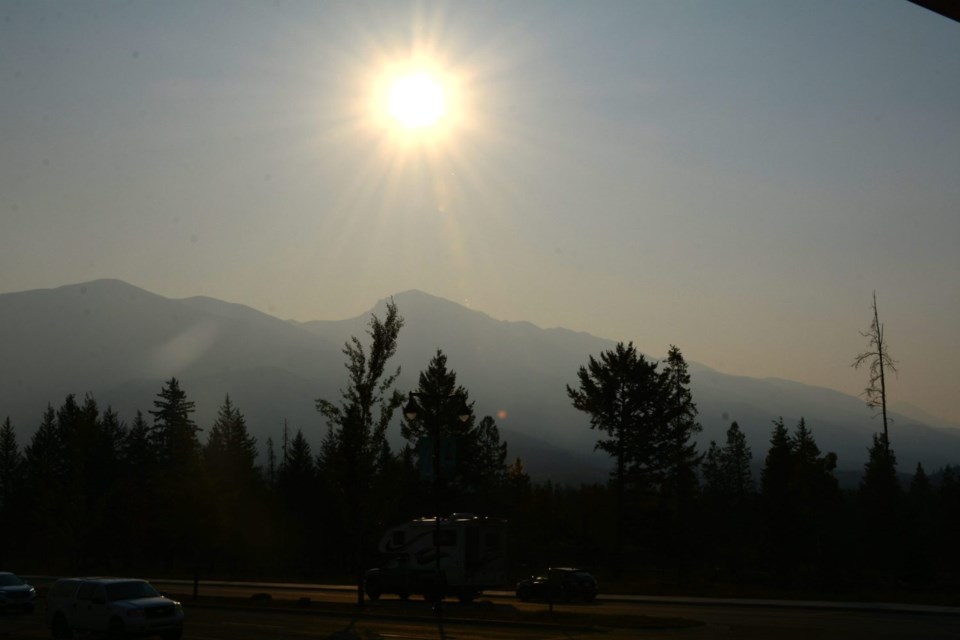Scott Hayes | [email protected]
Local Journalism Initiative Reporter
Jasper didn't experience the same heat that it did in 2022, though it did see much of the recurring and problematic wildfire smoke in the air that the rest of the province did.
"When we talk about the summer on average, it was an above-average year for all of Alberta in terms of temperature," said Justin Shelley, weather preparedness meteorologist with Environment and Climate Change Canada (ECCC).
Jasper National Park recorded only seven days where the temperature exceeded 30 C. The hottest day was July 9, which came in at 32.7 C. August, however, had five days at 30 C or hotter.
It was the precipitation that was more of a standout, although the most impressive weather moment came only a few days before the official start of summer. A freak storm passed through on June 19, bringing with it approximately 55 centimetres of snow and more than 100 millimetres of rain in parts of the national park.
Since June 21, Jasper has recorded nearly 105 millimetres of precipitation, whether it be rain, snow or otherwise.
For many people, however, it was the smoke that became the most pervasive and recurring problem, meteorologically speaking.
Kevin McCullum, data manager for the West Central Airshed Society, interpreted data from Jasper's three PurpleAir sensors, although only two have been in operation since the beginning of the summer. The third was installed mid-summer.
Looking at this data, Jasper's poorest air quality days came on May 17, July 13 and Sept. 3. The highest level of PM2.5 – referring to fine particulate matter sized 2.5 microns or less – was 258.7 while the highest 24-hour average was 175.1.
"Anytime it goes over 80, that's a concern," McCullum said. "That's the high limit for us. For the 24-hour average, it's anytime it goes over 29."
There were several occasions when Jasper's 24-hour average PM2.5 level went above 29, the most recent being on Sept. 9.
"Jasper and Hinton actually got off really good this year," McCullum said. "We had a really bad fire year in 2018. This is as bad if not worse in certain cases. The numbers that we saw in 2018 were higher than we have seen at this time, but the duration was shorter."
Last weekend, Jasper's air quality became poor again, but the WCAS data was provided before that. It was enough for ECCC to issue a special air quality statement.
"Wildfire smoke can be harmful to everyone’s health even at low concentrations," the statement read, warning that people with lung or heart disease, older adults, children, pregnant people and people who work outdoors are at higher risk of experiencing health effects caused by wildfire smoke.
"Stop outdoor activities and contact your health care provider if you or someone in your care experiences shortness of breath, wheezing (including asthma attacks), severe cough, dizziness or chest pains. Stay inside if you are feeling unwell and experiencing symptoms."
It also advises that people should wear a well-fitted respirator type mask (such as a NIOSH certified N95 or equivalent respirator) if they must spend time outdoors.
Exposure to PM2.5 can cause serious health problems including lung and heart disease, according to the Government of Alberta's website.
PM2.5 is typically a result of human activities and natural emission sources such as wildfire smoke, while some derives from dust or smoke and through chemical reactions in the atmosphere involving other gases, such as nitrogen dioxide, sulphur dioxide and volatile organic compounds.
Human-caused sources include the combustion of fossil fuels whether for vehicles, home heating, power plants or other industrial processes. PM2.5 can also result from home wood burning, brush pile burning, road dust and construction operations, among other sources.
The highest concentrations of PM2.5 are typically caused by wildfire smoke and winter smog, the Alberta website says.
PM2.5 is part of the Air Quality Health Index (AQHI) that reports on health risks associated with local air quality across Alberta in real-time.
According to the ECCC, both Edmonton and Calgary saw new records for the number of smoke hours, which it defines as hours in which visibility is equal to 9.7 kilometres or less due to smoke, as measured by observers at weather stations under 24/7 monitoring, such as at international airports. Records go back six decades.
Much of the smoke that plagued that province this summer actually originated from British Columbia and the Northwest Territories. By Tuesday, the predictive map offered on www.firesmoke.ca was looking at more wildfire smoke up to 28 μg/m3 of PM2.5 entering Jasper National Park. That map is based off of the BlueSky Canada forecast.




